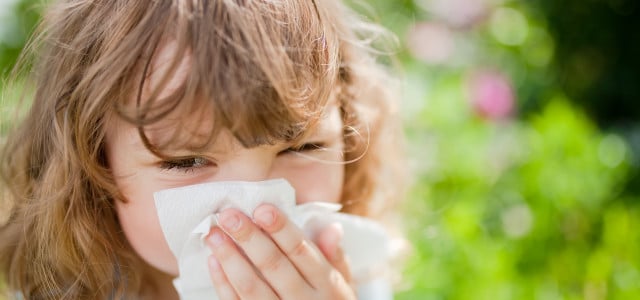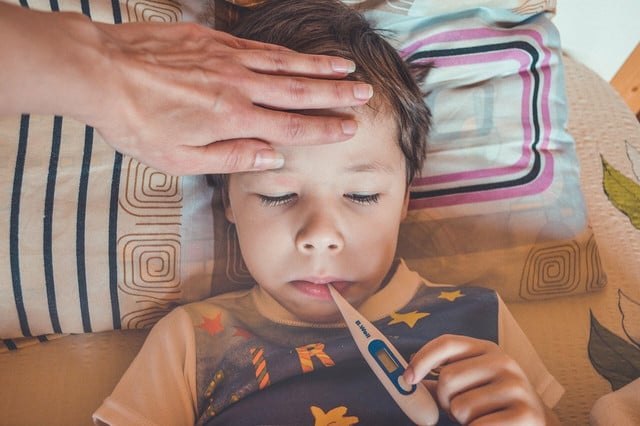
Many people are susceptible to hay fever in spring. Children also suffer from watery eyes and a runny nose. Utopia explains what symptoms occur – and what helps.
In the case of hay fever, the body’s immune system reacts to certain pollen that is carried through the air during the flowering period of plants. This includes pollen from trees, shrubs, herbs or grasses. So-called early bloomers (such as poplars, birches or alders) often trigger the inhalation allergy.
Did you know? According to information from the Association for Allergic Children, pollen allergies are not congenital, but develop over the course of life. However, there are certain risk factors, including cigarette smoke or “atopic dispositions,” i.e. familial predispositions. Although a parental history is no guarantee of hay fever, the chances increase as follows according to the DAK health insurance portal: If no family member is allergic, this risk is 5 to 15 percent. If one parent is affected, it is 25 to 30 percent. However, if both parents are allergic, the probability increases to 40 to 60 percent – and if both parents have the same allergy, even to 60 to 80 percent.
Symptoms of pollen allergy in children

(Photo: CC0 / Pixabay / Victoria_Borodinova)
According to the Robert Koch Institute, an average of nine to ten percent of children develop hay fever. It is noteworthy that, according to studies, children in cities suffer less from hay fever than children in rural areas.
Most of the time, the symptoms appear immediately upon or after contact with the pollen. Children suffering from hay fever usually develop irritated and inflamed nasal mucosa, as the immune system fights the substances that are mistakenly classified as “hostile”. As the antibodies release inflammatory substances, the mucous membranes swell whenever they come into contact with the allergens.
In addition to the symptoms mentioned, experts summarize that other allergic reactions also occur:
- sleep disorders
- itchy nose
- Headache
- Tiredness and exhaustion
- increased body temperature
- diffuse inflammations (including paranasal sinuses and middle ear)
- swollen eyelids
Children suffering from hay fever often also suffer from asthma or inflammatory skin diseases such as neurodermatitis.
Good to know: As pediatricians and adolescent doctors report online, a severe pollen allergy can significantly worsen a child’s well-being. Sometimes the ability to concentrate is limited, meaning that affected children cannot pay attention properly at school or kindergarten. They are generally more susceptible to cross allergies. For example, children who have hay fever often cannot tolerate certain foods.
When consumed, the allergy causes the following symptoms in the mouth and throat:
- itching
- Tingle
- Burn
A cross allergy can occur against various foods, depending on which plant pollen triggers the hay fever. For example, many people with a hazel, alder or birch pollen allergy also show symptoms against hazelnuts, apples or cherries. Typically, each type of pollen is linked to certain foods.
Hay fever in children: When should you seek medical attention?
If your child has severe hay fever, you should always seek medical advice from a pediatrician. The first step is to seek medical advice from a pediatrician. They can make a diagnosis based on the symptoms and carry out further tests.
The only way to determine the type of pollen is to use the so-called prick test. This involves applying different types of pollen dissolved in water to a small area of the skin on the forearm. If this type of pollen triggers the allergy, a reddish, swollen or itchy area will appear after about 20 minutes. The prick test is considered a reliable diagnostic tool for pollen allergies. Food allergies should, however, be investigated in other ways, such as blood tests.
Help with hay fever in children
In general, pollen allergies cannot be completely cured, even in children. However, there are ways and means to alleviate the symptoms. In a similar article, we tell you which home remedies help with itchy eyes.
We also recommend that you take the following measures to mitigate allergic reactions:
- Children can reduce pollen exposure themselves by adopting certain habits. These include, for example, not entering the bedroom in their street clothes and washing their hair after a trip outside. It is a good idea to wash street clothes in the washing machine as soon as possible.
- Depending on the type of pollen allergy, affected children should avoid certain foods on the recommendation of their pediatrician. People who are allergic to tree pollen often cannot tolerate certain types of fruit and nuts. They should also avoid spices such as garlic, anise or curry. Those who are allergic to grass or grain pollen should perhaps eat certain vegetables such as beans, peas or lentils in moderation.
- When pollen levels are high, car windows and windows should be kept closed. It is advisable to only ventilate the apartment at certain times: in the evening in the countryside, as there is the most pollen in the air in the morning. In the city, early in the morning, as pollen levels are highest in the evening.
The beginning of pollen flowering varies from year to year. Depending on the weather, the pollen concentration is higher or lower. When it rains, there is hardly any pollen in the air, while warm and dry weather encourages pollen to fly. According to the BMUV, climate change is also extending the pollen season.
Those affected should therefore inform themselves about the daily forecasts for the most important flower pollen in order to estimate the expected pollen count.
Hay fever in children: medication or home remedies?

(Photo: CC0 / Pixabay / cenczi)
In severe cases, drug therapies help to reduce symptoms:
-
Antihistamines weaken the immune response. Alternatively, there are drops, ointments and tablets for hay fever. In the case of more severe attacks, cortisone sprays can also slow down the immune response. However, the dose should always be kept as low as possible in children. The disadvantage of all medications is that they cause unwanted side effects. Those affected often become tired and less energetic after taking them, so it is advisable to only use the medication in the evening.
- Children who only show allergic reactions to a few types of pollen can be treated with hyposensitization. This involves treating the body with the highly diluted allergen for a period of time. If the treatment is successful, the body will eventually “tolerate” the substance.
- If possible, you should first try to alleviate the allergic symptoms with preventive measures and suitable home remedies. Gentle tissues and nasal rinses with sea or table salt promise relief. Essential oils also soothe the mucous membranes (including eucalyptus, fennel or sea buckthorn oil).
- Mountain air is very good for those suffering from hay fever, as the pollen count is rather low at higher altitudes.
Read more on Techzle\.com:
- Eyebright: Effects and use for eye problems
- Hay fever: Effective home remedies for a stuffy nose and itchy eyes
- Nasal douche: Everything about use and effect
Edited by Adriana Jodlowska
** marked with ** or orange underlined Links to sources are partly affiliate links: If you buy here, you are actively supporting Techzle\.com, because we then receive a small part of the sales proceeds. .